Filed under: Caves
My explorations and appreciation of caves is not limited to the geology. Caves are certainly not devoid of life, especially near the entrance. Bats are the most famous inhabitants of caves, a common fixture in Hollywood versions. I have indeed encountered Vampire bats in caves, but only in Central America. No, they didn’t attack. They are creatures of stealth, preferring to quietly open a vein on their victim, using teeth so sharp that it doesn’t wake a sleeping cow or human. Their guano is truly disgusting. Unlike the relatively inoffensive compost left by insect and fruit-eating bats, Vampire guano is digested blood, resembling a pool of chocolate sauce, but smelling like… well, it is indescribably nasty.
Caves in Kentucky are a bit more tame than tropical caves. Although there may be fairly large bat colonies in some North American caves, especially in the southwest, most bat colonies in the midwest are limited to a few thousand individual bats at most.( These days, our local bat colonies are under threat from White Nose Syndrome, a poorly understood fungal infection that is wiping out colonies in the northeast.) A tropical bat colony’s guano piles are intensely alive, seething with roaches and other insects and arachnids.
The bats support a whole ecosystem of other creatures that live on the bat guano or those that eat the bat guano. Cave crickets, Cave salamanders, millipedes, cave beetles and cave spiders are common. Seen less often are aquatic critters like blind cave fish and cave crayfish. These are highly specialized creatures, unable to survive outside of the cave environment.
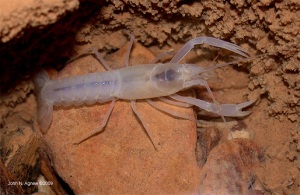
A Cave Crayfish--no pigment, no eyes
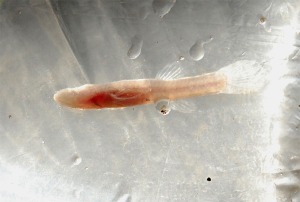
A blind cave fish from Pulaski County, KY
These animals live in a world of perpetual blackness. Beyond the twilight zone near the entrance, the darkness is absolute. Even powerful light amplification equipment will detect no light. So it is no surprise that permanent troglobitic animals have no eyes or pigment. There would be no use at all for these features. They feel their way through their world, using extra long antennae, or sensitive nerves tuned to the slightest vibrations. They are able to live on minimal diets in a very lean ecosystem.
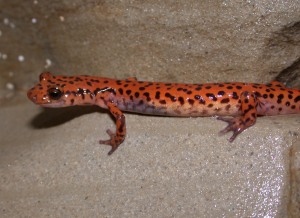
Cave Salamanders live near the entrance zone, where their insect prey is more plentiful
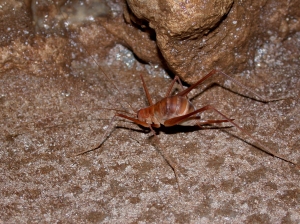
Cave crickets live near entrance zones, and leave the cave at night to feed
We were exploring a small cave in Kentucky that we had to excavate a bit to get into. Sediments had blocked the entrance leaving only a tiny hole blowing air. The airflow indicated a sizable cave, so we set about enlarging the entrance. Once I was able to squeeze my head and shoulders into the hole, I saw thousands of cave crickets, covering the walls and ceiling. Crawling into that cramped space with so many crickets would have meant having them literally in your face, and nose, ears, and mouth. We decided to come back at another time. Apparently we found the crickets queing up for their nightly foray onto the forest floor to eat. In Yucatan, we got to experience a major bat flight, similar to the one at Carlsbad Caverns in the US, where multiple thousands of bats fly out of the cave. We were inside a large room with an opening at the top. The bats began gathering as dusk approached, flying in circles around the room as more and more bats accumulated. Eventually the black cloud of living mammals spiraled out the opening. We sat on the floor looking straight up into the swirling bats. Awesome!
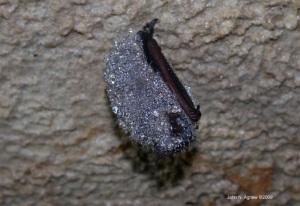

"Still Life with Cricket" 20 x15 acrylic on panel
I’ve been a caver for 37 years. Maybe longer if you count my childhood tendencies to crawl into dark places. For those not put off by the darkness or bats, caves have that something that excites the instinct to explore. Explore we have, mapping many miles of dark tunnels and crawlways under the green hills of Kentucky. For me, it wasn’t just about the thrill of discovery. Caves are an aesthetic experience, like underground sculpture galleries. The limestone is scalloped and fluted, and corroded into a swiss-cheese maze, sometimes decorated by fantastic crystalline ornaments.
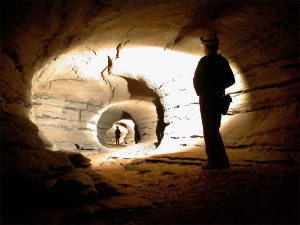
Wells Cave, an 11 mile system in southern KY
There is also the time-capsule factor. Because caves have no weather (if they are above flood stage levels), whatever changes made by visiting animals or humans last for tens of thousands of years. I’ve seen 4,500 year old footprints left by prehistoric Indian explorers and 10,000 year old tracks left by an ancient Jaguar in a Tennessee cave. I’ve seen 1,000 year old Mayan storage jars in Belizean caves that still contained corn cobs a couple of inches long, the ancestors of todays foot-long ears.

1,000 year old Mayan storage pots in a cave in Belize
I was once shown a pit in a cornfield in Yucatan by a Mayan friend. I rappelled into the 50ft pit, feeling pretty high-tech with my modern climbing and caving gear (sandals and candles are standard Mayan caving gear). On bottom, I found myself standing on a pile of debris in the middle of a flooded passage. I couldn’t proceed without swimming, so I looked down to see if I could spot any potshards. It was then that I realized I was standing on a pile of human bones! These were likely the victims of a battle that occurred here (the late Post-Classic city of Mayapan) several hundred years ago. I climbed back up the rope, using my mechanical ascenders that grip the rope and allow you to climb without risk of losing your grip and falling. I got to the top and found that a crowd of Mayan spectators had gathered. I sat on the lip of the pit while I derigged myself, and then clumsily dropped one of my ascenders into the pit. I cursed myself and prepared to do the climb all over again to retrieve the ascender, when a Mayan stepped forward, said “No ay problema,” and slid down the rope bare handed. He clenched the ascender in his teeth, and shinnied back up the rope in seconds. I feebly thanked him as he handed me the ascender. So much for feeling superior for possessing hi-tech gear.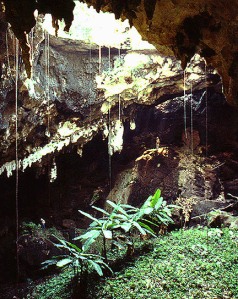
Nowadays I don’t do much of the hard-core exploration, crawling for miles, climbing hundred-foot pits, or spending 20 hours underground. That stuff is better suited for 20-somethings. I suppose I could lose some weight and whip myself into shape so that I could once again suffer for exploration, but my interests lie more in finding imagery. A casual stroll with a camera and tripod are more to my liking. Of course, there is rarely such a thing as a casual stroll in a wild cave. Cameras have to be packed in waterproof boxes and handled carefully to prevent their destruction by dust infiltration. To find caves free of trash and graffiti means going to places that have “nerd filters” as they are called in the caving parlance. These filters are usually deep pits, or tight, long and difficult crawlways. Things to discourage the casual caver, which I would like to be most days. I guess we do have to suffer for our art. See http://www.johnnagnew.com for examples of my cave art.
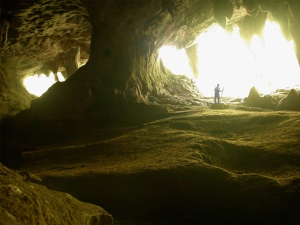
A burial cave in Sarawk, Malaysia (Borneo)

I’m not afraid of spiders. I am not afraid of spiders. Actually, I’m not, really. I actually think some are cute, like the Jumping spiders (Phidipus).
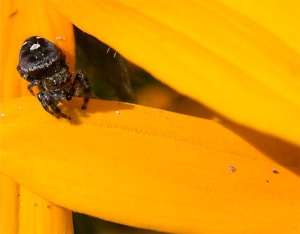
Their big eyes are kind of endearing, even if the big green fangs put you off a little. I like the way they turn their head to look at you. You get the feeling that there is an intelligence evaluating you behind those eyes. All spiders amaze me because of the fantastic variety of forms, and the incredible things they do despite having brains the size of gnat eggs. My inner 15 year old is also fascinated by their use of venom and the fact that most people think spiders are hideous monsters. I suppose I would feel the same way if I were the size of an insect, or if spiders were the size of lions. My affection for Jumping spiders is definitely related to the way their two large eyes gives them a “face.” Most spiders have multiple eyes and lots of wiggly pedipalps and fangs, not exactly a visage that appeals to human nurturing instincts. However, being tiny and colorful helps spiders overcome our fear of the weird. Once we start to appreciate the more attractive ones, we can also begin to love the Godzillas of the spider world.
The Pink-Toed Tarantula that we’ve seen in Peru is a spider-hater’s nightmare, bigger than your hand and with big hairy legs. The hairs help them to use surface tension to cross water between trees during the flood season. They have fearsome-looking fangs, but don’t seem very aggressive. They can be handled safely if you’re gentle with them.
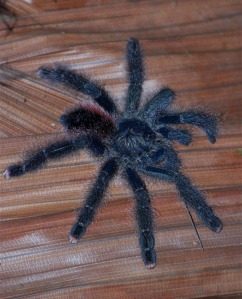 The Pink-Toed Tarantula
The Pink-Toed Tarantula
The Lycosid spiders (the Wolf spiders and their kin), get nearly as large as tarantulas and are much more active hunters. It was in the Amazon that I saw one large enough to turn the tables on a frog. In my experience, placing an appendage anywhere near a big wolfy is asking for a bite. The spiders just reflexively pounce on anything that touches them. The unlucky treefrog just happened to touch the leg of this large, hungry spider.
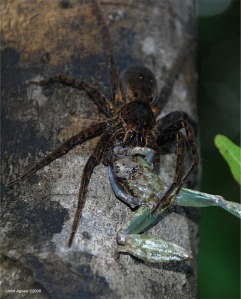 Lycosid spider eating a frog
Lycosid spider eating a frog
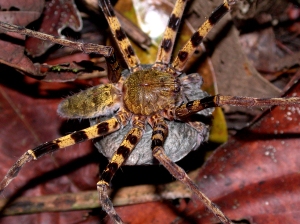
A Huntsman Spider in Borneo, carrying its egg case
It is right here in Ohio (a friend’s office to be more specific) where the Brown Recluse lives. These nondescript little brown spiders cause hideous ulcerous wounds with their bite. The one bite I’ve seen looked like the aftermath of a copperhead bite. There have been no recorded deaths from the Brown Recluse to my knowledge, but I’ll keep my distance.
I haven’t done any spider art yet, but I do like to photograph them!
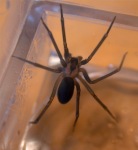
The Brown Recluse has a violin-shaped mark on its back (actual size)
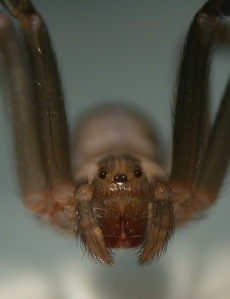
A Brown Recluse Spider
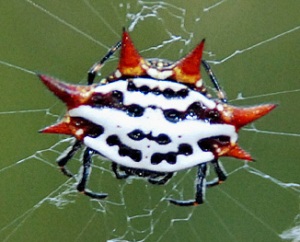
A Florida Crab spider
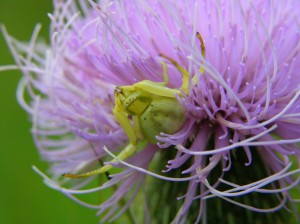
An Ohio Crab spider
Filed under: Adventures
I have a small garden pond in my city backyard (I’m 5 minutes from downtown), but it is an oasis of wilderness. My favorite creatures that inhabit the pond are the frogs. There are Green frogs (Rana clamitans melanota), and Bullfrogs (Rana catesbeiana). The Bulls dominate the pond, eating everyone but the largest Green frogs. In fact, they eat everything that can fit in their mouth. I have seen Bullfrogs with 8-inch goldfish hanging out of their mouth, eating Goldfinches and sparrows, and even attacking (unsuccessfully) Mourning Doves. I once watched a hummingbird dodge a frog that launched himself straight up to catch the little bird. The hummer “stepped” aside like a matador, and the frog flew past with an open mouth. I have since read that Bullfrogs are the major predator of hummers. A hummingbird would only be a small, feathery snack for a big frog.
The best part of having frogs in the yard is their croaking. As soon as the evening air is warm, they begin the choruses of “Jug-O-Rum” (Bullfrogs) and the out-of-tune banjo pluckings of the Greens frogs. Loud noises seem to stimulate singing, like jets overhead or trucks rumbling by. I sometimes stand out there and croak at the frogs, getting them to talk back. Of course, my wife and my neighbors just think I’ve finally lost it. As mating time approaches, the males do combat like little sumo wrestlers. They go belly to belly, trying to push their rival over. They also try to jump on top of each other. There is a lot of competition for the choice nesting spots, usually at the base of some emergent plants like bullrush or water iris.
Last year I got to watch a green frog lay her eggs, with her attendant male hanging on in amplexus. The eggs spewed out in a couple of seconds, and the little white centers darkened quickly. The eggs hatched in just a couple of days, with tiny little black tadpoles wiggling free and sinking into the depths.
The pond is about five years old, and I’ve had a couple of crops of tadpoles make the metamorphosis. It takes two summers for the tadpoles to mature. Unfortunately, the adult frogs seem to love the taste of new frogs, so a lot of them get gobbled up before they’ve eaten their first bug. Garter snakes also take a toll, but that’s nature, and I enjoy seeing the snakes as much as I do the frogs. I get a thrill out of seeing a garter snake glide across the pond just as I would seeing an anaconda in the Amazon. You take your thrills where you find them.
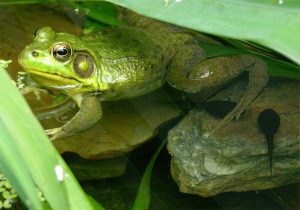
A male Green frog with last year's tadpoles
Of course, the pond and its frogs are a great source of images for my artwork. Ponds and their reflections are endlessly fascinating. The frogs give it some personality.

"Waterlily and Frog" 8x10 acrylic on panel
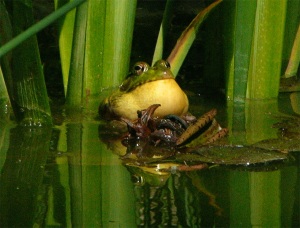
A Green Frog singing in my pond
A little over a year ago, I was incredibly lucky and got to see an Ivory-Billed Woodpecker as it passed almost directly over my head while I sat in a Kayak near Bruce Creek in northern Florida. Mind you, this was my first attempt to find an Ivory-Bill, and it happened less than 24 hours after I arrived in the area. Is that lucky or what? I know people who have searched for years without seeing one. Of course, I had to share this experience, and the best way for me to do that is through my artwork (I missed getting the photo). The painting captures not only the bird, but the incredible setting in which I had this experience. A misty morning, the rising sun illuminating ancient cypress, the distant calls of Barred Owls, and then… “Ivory-Bill!”
I now have made available giclee canvas prints of my painting, “Ivory-Bill!” My plan is to donate 20% of the proceeds to Geoff Hill’s Ivory-Bill research project. The 16×20 canvas print is mounted on wooden stretchers, coated, signed & numbered by the artist (me!), in an edition of 250. Number one has been sold, number 2 is available for you. See my art website, http://www.johnnagnew.com for price and ordering details. I will attempt to keep this blog updated as to which print number is currently available.
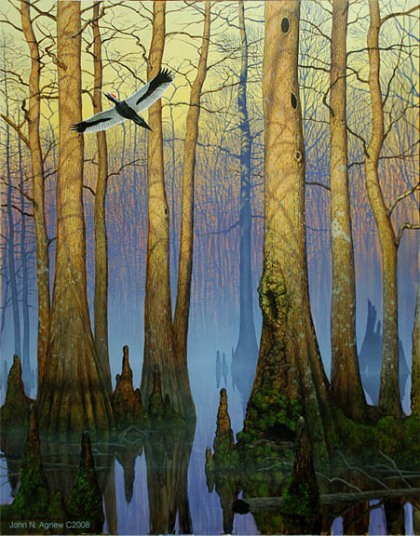
Filed under: Adventures
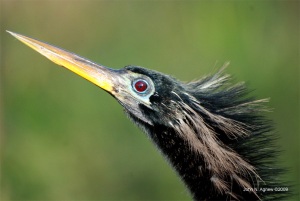
Anhinga at its namesake trail.
I used to live in south Florida and visited the Glades quite often back in the late 70’s- early 80’s. It was my introduction to tropical ecosystems, and as a life long reptile lover, something of a “holy” place for me. After reading of the adventures of famous herpetologists there, it was really exciting to see it for myself.
We went back this past January, after an absence of nearly 20 years. It was a very nostalgic trip, but we couldn’t help but feel that the place had diminished somewhat. Some of our favorite trails were closed because of storm damage, and we noticed even more exotic invasive plants. Although we didn’t see one for ourselves, Burmese Pythons have become a scourge since our last visit. I’ve read of extensive mercury contamination of the Park waters. It is no longer healthy to eat fish from the Glades.
Still, we saw much of the beauty we expected to see. The vistas of vast sawgrass prairies are still there. The great pine savannahs are still there. Even some of the huge old mahogany trees in Mahogany Hammock have survived the hurricanes that blasted through the park in the last 20 years.
The bird life concentrated at the usual spots (Anhinga Trail, Mrazek Pond) was still in evidence, and I got some wonderful reference photos.
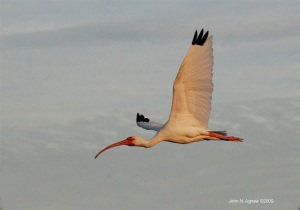
White Ibis in the light from sunset
However, I read that birdlife in the Glades is only 20% of what it was in the 80’s! Back in the 80’s, I read that the bird life was only 10% of what it was before man intervened around the turn of the last century. That’s pretty discouraging. There are efforts underway to restore the Glades to some of its former glory, but money and politics still get in the way. An effort by the state of Florida to buy up sugar cane fields south of Lake Okeechobee has been much reduced by the recent economic downturn. These lands are critical to restoring the flow of clean water into the Everglades. For me, the place is still a wonderful source of images. Inside the Park, the vistas haven’t changed much, and I can find truly sublime visions.
Gators have always been an interest of mine, and they give the place a very Cretaceous-like aspect. Cypress and alligators go all the way back to those Mesozoic days, although the cypress were in Canada back then.

An alligator at Shark Valley
Back in our early days of visiting the Park, I searched for the American Crocodile. In nearly seven years of trying, I never did see one. On this recent trip, I spotted five in one morning. It’s nice to know that something there is making a real comeback. I also got to see a cottonmouth. I never managed to find one before, although I knew they were around. It was a beautiful specimen, looking freshly shed and very colorful. It was lying in the middle of the main park road, a very risky basking spot. I tried to encourage it to leave the pavement, while steering traffic around the snake with my flashlight. As cars passed, I’d illuminate the snake so they could appreciate my efforts. I wish I could have heard the comments.
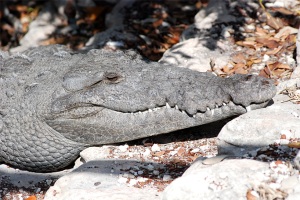
The head of a 10-foot American Croc basking near the docks at Flamingo
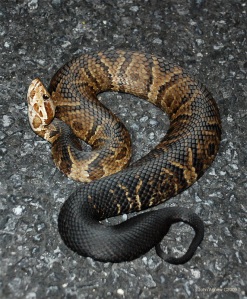
A Florida Cottonmouth on the main road.
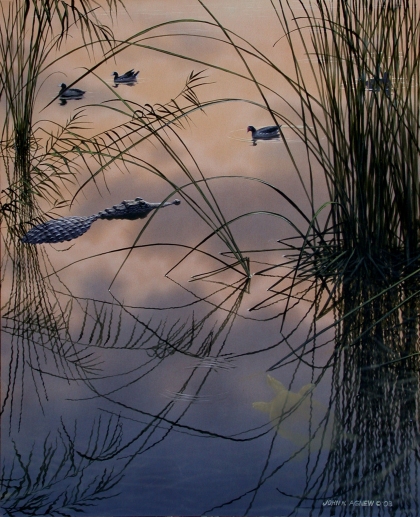
"Everglades Morning" is currently on display in the US Embassy in Costa Rica.